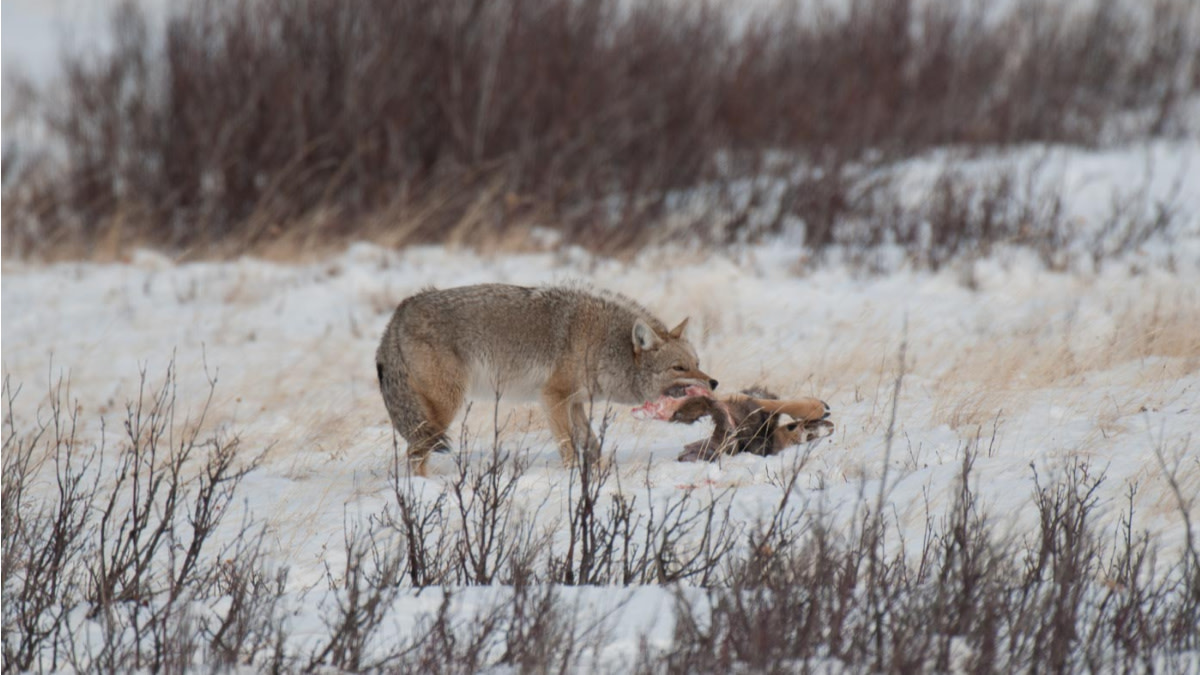
The howl of a coyote has spread across the Eastern United States, stirring concern and debate among deer hunters and wildlife managers. But according to a new multi-state, decades-long study, whitetail deer have continued to thrive even as coyote populations boomed.
Hunters are often leery of change—especially regarding a new predator they perceive as competition. Of course coyotes eat deer meat given the opportunity, either deer they kill outright or carcasses they scavenge. And several small-scale studies have shown that coyote predation can push down local deer populations.
According to this research, however, hunters can breathe easier. In the big picture, deer can handle—even thrive—under new pressure from coyotes. The study, “Effects in White-Tailed Deer Following Easter Coyote Colonization,” was published in the Journal of Wildlife Management in 2019.
A team of researchers looked at game records from 384 counties totaling 200,000 square miles across six Eastern states: Florida, New Jersey, New York, North Carolina, Ohio, and South Carolina. This area was chosen because of the diverse climate and geographical conditions across the landscape. Also, these states were on the cutting-edge of coyote colonization of the Eastern U.S. The study area is roughly one-third forested and one-third in agriculture, the rest water, towns, roads, and the other features.
Researchers looked at deer harvest data from 1981 to 2014, as coyotes took over this new territory. “If coyotes are affecting deer, we expected that deer population growth rates would decline following coyote colonization,” the researchers wrote.
But that is not what happened. Indeed, just the opposite occurred. Even after coyotes got a toe hold and spread, hunters killed more deer.
“We did not detect any negative association between colonizing eastern coyotes and white-tailed deer population growth rates across six eastern states. Instead, we documented a consistent rise in deer abundance simultaneous to coyote colonization across the region.”
The researchers noted small, local declines in deer numbers, but overall deer numbers were up across the board. Sometimes, way up.
“The absence of an effect of coyotes on deer population growth was consistent over the course of coyote colonization,” the researchers found.
What’s going on? If you’ve got thousands of new predators producing litters of pups to feed, wouldn’t they hammer the deer herds? Nature isn’t that simple.
Biologists talk of “compensatory” versus “additive” mortality. Think of a deer herd as a bank account that produces interest. If you spend all the interest and dig into the principal, your account will shrink. That is additive mortality.
But if you don’t spend all the interest (or eat all the fawn crop), the account continues to grow.
Furthermore, some of those fawns that were killed by coyotes may have died by other means, had the coyotes not been present, perhaps killed by a car, starved during a harsh winter, or died in a disease outbreak. So those predation losses are canceled out because of losses that would have otherwise occurred. It makes no difference to the overall population if the fawn was eaten, roadkilled, or starved. This is compensatory mortality.
Fawns are most vulnerable to predation when they are under a few weeks old—before they are able to keep up with their mothers.
“Basically, coyotes mostly leave adult females alone and adult females are the most important cohort of the population when it comes to reproduction,” said the lead author, Eugenia Bragina, now with the Wildlife Conservation Society.
Focusing on habitat may be more cost-effective than broadside attempts to reduce coyote numbers. For one, coyotes are prolific and quickly bounce back from culls.
“Because we detected no signal for eastern coyotes causing a decline in whitetail deer over time, our results imply that coyote removal would have little effect on increasing deer numbers in this region. Although coyote control could impact local deer dynamics for a short period of time in some situations, we do not expect coyote removal would be able to increase deer population size at a large spatial scale.”
If guided by political pressure instead of biology, wildlife managers can end up wasting a lot of money trying to control coyotes with no real benefit, said Bragina.
“A lot of this is about perception,” she said. “We need to get used to the idea that coyotes are going to be around. They are here to stay.”
The bumper sticker, “Save a deer, kill a coyote,” is overly simplistic. If you want to hunt or trap coyotes for fur and fun, go for it. But odds are the deer will do just fine on their own.
Feature image via Tony Bynum.







Conversation